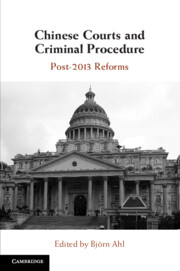Book contents
- Chinese Courts and Criminal Procedure
- Chinese Courts and Criminal Procedure
- Copyright page
- Contents
- Figures and Tables
- Contributors
- Acknowledgements
- Abbreviations
- 1 Post-2013 Reforms of the Chinese Courts and Criminal Procedure
- 2 The Meandering Path of Judicial Reform with Chinese Characteristics
- 3 Dimensions and Contradictions of Judicial Reforms in China
- 4 How the Supreme People’s Court Drafts Criminal Procedure Judicial Interpretations
- 5 Judicial (Dis)Empowerment and Centralisation Efforts
- 6 A New Model of Habeas Corpus in China? Procuratorial Necessity Examination of Pretrial Custody
- 7 Live Witness Testimony in the Chinese Criminal Courts
- 8 Blood Money and Negotiated Justice in China
- 9 Performance Evaluation in the Context of Criminal Justice Reform
- 10 From Populism to Professionalism
- Index
9 - Performance Evaluation in the Context of Criminal Justice Reform
A Critical Analysis
Published online by Cambridge University Press: 25 June 2021
- Chinese Courts and Criminal Procedure
- Chinese Courts and Criminal Procedure
- Copyright page
- Contents
- Figures and Tables
- Contributors
- Acknowledgements
- Abbreviations
- 1 Post-2013 Reforms of the Chinese Courts and Criminal Procedure
- 2 The Meandering Path of Judicial Reform with Chinese Characteristics
- 3 Dimensions and Contradictions of Judicial Reforms in China
- 4 How the Supreme People’s Court Drafts Criminal Procedure Judicial Interpretations
- 5 Judicial (Dis)Empowerment and Centralisation Efforts
- 6 A New Model of Habeas Corpus in China? Procuratorial Necessity Examination of Pretrial Custody
- 7 Live Witness Testimony in the Chinese Criminal Courts
- 8 Blood Money and Negotiated Justice in China
- 9 Performance Evaluation in the Context of Criminal Justice Reform
- 10 From Populism to Professionalism
- Index
Summary
This chapter analyses the operation of criminal procedure in contemporary China from the perspectives of institutional and individual interests. First, the chapter zooms in on the various performance indicators that affect the everyday operation of China’s criminal justice system, with a focus on the distorted use of such indicators. Second, it argues that the pathological use of performance indicators must be understood in the context of the power relations and interactions amongst the main players within the criminal justice system. Incentivising and controlling the individual actors can be thought of as managing an enterprise on the basis of individuals’ interest in pursuing promotion and better remuneration and agencies’ interest in obtaining power, prestige and legitimacy. Ingenious individuals and agencies soon develop techniques for disregarding, bypassing or manipulating performance-related factors to obtain the results they want. The downside of such an interest-driven management approach in the criminal justice arena is that it conflicts with the underlying mission of criminal justice agencies: to serve the interests of justice. Finally, the chapter analyses the current criminal justice practices, identifying the ideological and institutional factors that can explain the distortion and limits of reform.
- Type
- Chapter
- Information
- Chinese Courts and Criminal ProcedurePost-2013 Reforms, pp. 235 - 257Publisher: Cambridge University PressPrint publication year: 2021
- 3
- Cited by

